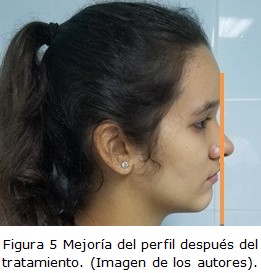Utilization of the modified Nance button for mandibular propulsion
Abstract
Introduction: In the beginning, most of the functional appliances were removable, but the fixed ones are increasing every day. Their combination can increase the effectiveness in the treatment of mandibular retrognathymus.
Objective: To present the results of the treatment of a patient with mandibular retrognathism treated with the modified Nance button.
Case report: A 13-year-old female patient with convex profile, neuromuscular dysfunction, permanent dentition in both jaws with the presence of slight anterior crowding, bilateral distoclusion molar ratio of ½ unit, incisor protrusion and overhang of 6 mm, poor intermaxillary relationship caused by retrognathism of the mandible and little remnant of active mandibular growth. The first stage of treatment included psychotherapy, myotherapy and mandibular advancement with a fixed functional appliance (modified Nance button for mandibular propulsion). Nine months after starting the treatment, the change in the intermaxillary relationships in the anteroposterior direction was verified, with a decrease in the ANB angle to 20 and an increase in the SNB to 78, as a reflection of a good relationship of the bone bases due to mandibular growth.
Conclusions: One year after treatment with the modified Nance button for mandibular propulsion, a correct relationship of the patient's bone bases was achieved.
DeCS: ORTHODONTICS/instrumentation; JAW ABNORMALITIES; ACTIVATOR APPLIANCES; MALOCCLUSION, ANGLE CLASS II; ORTHODONTIC APPLIANCES, FIXED.
Downloads
References
1. Herrera Navarrete IS, Torres Jiménez A. Ortopedia funcional de los maxilares en el tratamiento temprano de maloclusiones clase II por retrusión mandibular: reporte de caso clínico. Rev Mex Ortodoncia [Internet]. Jul-Sep 2017 [citado 12 Ago 2020];5(3):170-175. Disponible en: https://www.sciencedirect.com/science/article/pii/S2395921517300831
2. Al-Jewair T, Ghorbaniparvar M, Franchi L, Flores-Mir C. Comparison of treatment outcomes with crowned and banded mandibular anterior repositioning appliance (MARA) in Class II pubertal subjects: A retrospective cohort study. Int Orthod [Internet]. 2020 Jun [citado 19 Ago 2020];18(2):297-307. Disponible en: https://pubmed.ncbi.nlm.nih.gov/32111577/.
3. Ardeshna A, Bogdan F, Jiang S. Class II correction in orthodontic patients utilizing the Mandibular Anterior Repositioning Appliance (MARA). Angle Orthod [Internet]. 2019 May [citado 19 Ago 2020];89(3):404-410. Disponible en: https://www.ncbi.nlm.nih.gov/pmc/articles/PMC8117687/.
4. Moresca AHK, Dias de Moraes N, Topolski F, Flores-Mir C, Moro A, Moresca RC, et al. Esthetic perception of facial profile changes in Class II patients treated with Herbst or Forsus appliances. Angle Orthod [Internet]. 2020 Jul [citado 19 Ago 2020];90(4):571–577. Disponible en: https://www.ncbi.nlm.nih.gov/pmc/articles/PMC8028457/.
5. Dischinger BM. Skeletal class II case presentation: Utilization of the advansync 2 appliance. APOS Trends Orthod [Internet]. 2018 [citado 01 Sep 2020];8:168-74. Disponible en: https://apospublications.com/skeletal-class-ii-case-presentation-utilization-of-the-advansync-2-appliance/.
6. Márquez Pinto LV. Aparatos Funcionales Fijos - Propulsores Mandibulares [tesis]. Lima: Universidad Inca Garcilaso de la Vega; 2017 [citado 31 Ago 2020 Ago 31]. Disponible en: http://repositorio.uigv.edu.pe/bitstream/handle/20.500.11818/1325/Segunda%20Especialidad%20Leslie%20Ver%C3%B3nica%20M%C3%A1rquez%20Pinto.pdf?sequence=2&isAllowed=y
7. Proffit WR, Fields HW, Sarver DM. Ortodoncia contemporánea. 4ta ed. Barcelona: Elsevier; 2008.
8. Cançado RH, Janson G, Tompson B, de Castro Alvares JC, Pinelli Valarelli F, Salvatore Freitas KM. Treatment Effects of the Herbst Appliance in Class II Malocclusion Patients after the Growth Peak. Eur J Dent [Internet]. 2021 Feb [citado 31 Ago 2020];15(1):39-46. Disponible en: https://www.ncbi.nlm.nih.gov/pmc/articles/PMC7902098/.
9. Otaño Lugo R. Manual clínico de Ortodoncia. La Habana: Editorial Ciencias Médicas; 2008.
10. Bass N. Our Practice [Internet]. London: Bass Orthodontics Academy; 2011. [citado 2018 Jan 20]. Disponible en: http://bassorthodontics.com/our-practice/dr-neville-bass
11. Luis Acosta AC, Pérez García LM, de la Rosa Cabrera Y, Reytor Saavedra E, León Casanova O. Utilización del Neville Bass en el tratamiento del retrognatismo mandibular. Reporte de caso. Gac Méd Espirit [Internet]. Sep-Dic 2018 [citado 12 Jul 2020];20(3). Disponible en: http://scielo.sld.cu/scielo.php?script=sci_arttext&pid=S1608-89212018000300128&lng=pt&nrm=iso
12. Manni A, Migliorati M, Calzolari C, Silvestrini-Biavati A. Herbst appliance anchored to miniscrews in the upper and lower arches vs standard Herbst: A pilot study. Am J Orthod Dentofacial Orthop [Internet]. 2019 Nov [citado 12 Ago 2020];156(5):617-625. Disponible en: https://pubmed.ncbi.nlm.nih.gov/31677670/.
13. Martina S, Di Stefano ML, Paduano FP, Aiello D, Valletta R, Paduano S. Evaluation of Profile Changes in Class II Individuals Treated by Means of Herbst Miniscope Appliance. Dent J (Basel) [Internet]. 2020 Mar [citado 12 Ago 2020];8(1):27. Disponible en: https://www.ncbi.nlm.nih.gov/pmc/articles/PMC7175301/.
14. Moreira Oliveira P, Cheib-Vilefort PL, de Pársia Gontijo H, Aquino Melgaço C, Franchi L, McNamara J, et al. Three-dimensional changes of the upper airway in patients with Class II malocclusion treated with the Herbst appliance: A cone-beam computed tomography study. Am J Orthod Dentofacial Orthop [Internet]. 2020 Feb [citado 12 Ago 2020];157(2):205-211. Disponible en: https://pubmed.ncbi.nlm.nih.gov/32005472/.
15. Taylor KL, Evangelista K, Muniz L, de Oliveira Ruellas AC, Valladares-Neto J, McNamara J, et al. Three-dimensional comparison of the skeletal and dentoalveolar effects of the Herbst and Pendulum appliances followed by fixed appliances: A CBCT study. Orthod Craniofac Res [Internet]. 2020 Feb [citado 12 Ago 2020];23(1):72-81. Disponible en: https://www.ncbi.nlm.nih.gov/pmc/articles/PMC7310571/.
16. Cueto Salas A, Fernández Ysla R. Efectividad del Equiplán en el tratamiento del Síndrome de Clase II División 1. Rev haban cienc méd [Internet]. Sep-Oct 2014 [citado 20 May 2018];13(5). Disponible en: http://scielo.sld.cu/scielo.php?script=sci_arttext&pid=S1729-519X2014000500011
17. Hernández Silva JA, Rodríguez Manjarrés C, Molina Betancourt N. Cambios cefalométricos obtenidos con activador abierto elástico de Klammt como tratamiento temprano de maloclusión clase II. Rev Nac Odontol [Internet]. 2017 [citado 20 May 2018];13(25). Disponible en: https://revistas.ucc.edu.co/index.php/od/article/view/1704
18. Cerrillo Lara D, García Landin L, García Nava R. Corrección de maloclusión clase II mediante el uso del aparato de reposicionamiento anterior mandibular. Rev Tame [Internet]. 2019 [citado 19 Ago 2020];8(22):891-894. Disponible en: https://www.medigraphic.com/pdfs/tame/tam-2019/tam1922k.pdf
19. García Ramos RC. Nuevo aparato ortopédico fijo para el tratamiento de maloclusiones clase II división 1. Reporte de caso. Univ Odontol [Internet]. Ene-Jun 2018 [citado 01 Sep 2020];37(78). Disponible en: https://revistas.javeriana.edu.co/files-articulos/UO/UO%2037-78%20(2018-I)/231260072009/.

Published
How to Cite
Issue
Section
License
Copyright: Camagüey Medical Archive Magazine, offers immediately after being indexed in the SciELO Project; Open access to the full text of the articles under the principle of making available and free the research to promote the exchange of global knowledge and contribute to a greater extension, publication, evaluation and extensive use of the articles that can be used without purpose As long as reference is made to the primary source.
Conflicts of interest: authors must declare in a mandatory manner the presence or not of conflicts of interest in relation to the investigation presented.
(Download Statement of potential conflicts of interest)
The Revista Archivo Médico de Camagüey is under a License Creative Commons Attribution-Noncommercial-No Derivative Works 4.0 International (CC BY 4.0).
This license allows others to distribute, to mix, to adjust and to build from its work, even for commercial purposes, as long as it is recognized the authorship of the original creation. This is the most helpful license offered. Recommended for maximum dissemination and use of licensed materials. The full license can be found at: https://creativecommons.org/licenses/












 22 julio 2025
22 julio 2025